Labour Force
- Home
- Statistics
- Labour Market
- Labour Market Information
- Labour Force
Key Statistics of Labour Force in Malaysia, April 2021
Key Statistics of Labour Force in Malaysia, March 2021 7 May 2021
Principal Statistics of Labour Force, Malaysia, First Quarter (Q1) 2021 22 April 2021
Labour Force Survey Report, Malaysia, 2020 8 April 2021
Key Statistics of Labour Force in Malaysia, February 2021 8 March 2021
Key Statistics of Labour Force in Malaysia, January 2021 8 February 2021
Key Statistics of Labour Force in Malaysia, December 2020 Show all release archives
Overview
_v11-01.png)
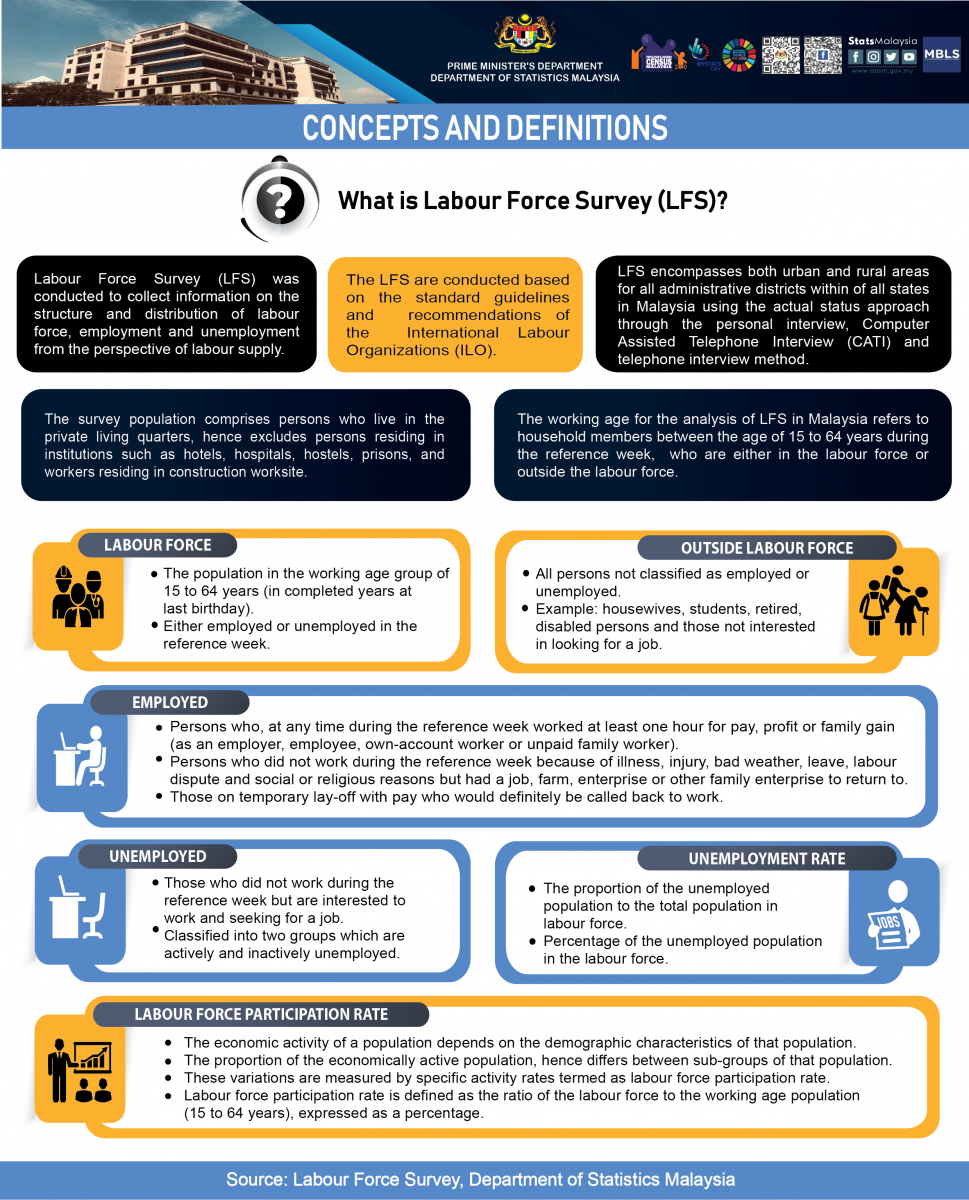
KEY REVIEWS
-
In April 2021, the number of employed persons remained in an increasing trend with month-on-month changes of 0.1 per cent or equivalent to 22.7 thousand persons to record 15.35 million persons (March 2021: 15.33 million persons).The employment-to-population ratio which indicates the ability of an economy to create employment remained unchanged at 65.4 per cent in April 2021.
-
From the viewpoint of economic sector, Services registered an upward trend in the number of employed persons during the month largely in Wholesale & retail trade; Food and beverages services, Education and Human health & social work activities. Similar trend were also observed in Manufacturing and Construction sectors while both Agriculture and Mining & Quarrying sectors continued to record a negative month-on-month momentum.
-
The largest composition of employed persons was the employee’s category which comprised of 77.9 per cent, increased by 17.2 thousand persons month-on-month to register 11.96 million persons (March 2021: 11.95 million persons). Similarly, own-account workers registered an addition of 12.3 thousand persons to record 2.49 million persons in April (March 2021: 2.48 million persons).
-
The unemployment rate continued to decline in April 2021, lessening by 0.1 percentage point to 4.6 per cent as against the previous month (March 2021: 4.7%). The number of unemployed persons reduced by 10.5 thousand persons (-1.4%) month-on-month to register 742.7 thousand persons (March 2021: 753.2 thousand persons).
-
In April 2021, the number of labour force was higher by 0.1 per cent or 12.2 thousand persons to 16.09 million persons (March 2021: 16.08 million persons). Despite the increase in the number of labour force, the labour force participation rate (LFPR) stood at 68.6 per cent during the month (March 2021: 68.6%).
-
The number of outside labour force during the month was higher by 0.2 per cent (+13.1 thousand persons) to 7.38 million persons as compared to 7.36 million persons in March 2021. Outside labour force was dominated by schooling/ training categories with 43.5 per cent (3.21 million persons) and followed by housework/ family responsibilities with 42.1 per cent (3.10 million persons).
-
May 2021 witnessed the public health crisis situation in Malaysia becoming more challenging with a rise in the number of daily infections cases, hence resulting in the implementation of MCO 3.0 nationwide until 31 May 2021. Furthermore, looking at the escalating number of COVID-19 cases and the sharp increase in daily cases towards the end of May 2021, resulted in the implementation of the total lockdown imposed nationwide from 1 to 14 June 2021 with the closure of all economic and social sectors except for essential economic and service sectors. Hence, the labour market condition is foreseen to face another tough situation in the upcoming months.
LABOUR FORCE REMAINED OPTIMIST IN APRIL 2021 WITH SLIGHT IMPROVEMENT IN NUMBER OF EMPLOYED PERSONS AND LOWER UNEMPLOYMENT RATE
The new daily cases of COVID-19 in April 2021, increased of about 1,000 and reached more than 3,000 towards the end of the month. During this period, most states were in Recovery Movement Control Order (MCO), with the exception of the largely populated states namely Johor, Kelantan, Kuala Lumpur, Selangor and Pulau Pinang which were in Conditional MCO. In particular, MCO was implemented in Kelantan from 16 to 29 April, and extended to 17 May. Inter-state travelling was still not allowed; however, most of economic activities were operating adhering to strict standard operating procedures (SOP).
April this year observed more bazaars, buffets and night market activities following of Ramadhan, unlike the previous fasting month in 2020, whereby all of these activities were restricted. Hence, along with festive season, businesses had seen more demand, thereby allowing some relief to the labour market situation. Additionally, secondary schools had reopened, thereby allowing education-related businesses such as school canteens and bus services to expand their operations.
In summary, labour force remained optimist in April 2021 with slight improvement in number of employed persons and lower unemployment rate. Moreover, monthly indicators of exports and imports continued to post a positive growth with 0.6 per cent and 5.4 per cent respectively. Better business outlook was also reflected by the performance of Leading Index (LI) for March 2021 which posted an increase of 1.8 per cent month-on-month (February 2021: 1.1%).
Despite the labour force positive situation in April 2021, it may be short-lived with the nationwide MCO implemented starting on 12 May 2021. The uncertainties of labour market may had emerged as the country faced the rapid climb in the new cases. In the bright side, the expansion of the COVID-19 vaccination programme through the voluntary opt-in registrations from May 2021 onwards may post signs of better recovery in the economy and subsequently in the labour market.
The Labour Force Report for April 2021 describes the labour supply situation as the country entered the fourteenth month of various phases MCO. The report will elaborate on the month-on-month changes to examine the immediate effects of the MCO to contain the spread of COVID-19. Users are advised to interpret the monthly statistics with caution since they are non-seasonally adjusted. In addition, annual changes from the same month of the previous year are also reported.
Employed persons remained in an increasing trend with month-on-month changes of 0.1 per cent
In April 2021, the number of employed persons remained in an increasing trend with month-on-month changes of 0.1 per cent or equivalent to 22.7 thousand persons to record 15.35 million persons (March 2021: 15.33 million persons). Similarly, on year-on-year basis, the number of employed persons continued its upward changes for two consecutive months, registering a stronger year-on-year growth of 2.8 per cent (March 2021:0.6%; April 2020: -1.0%) or 418.6 thousand persons (April 2020: 14.93 million persons). This year-on-year increase was due to low base of number of employed persons during April last year as a result of nationwide total lockdown.
From the viewpoint of economic sector, Services registered an upward trend in the number of employed persons during the month largely in Wholesale & retail trade; Food and beverages services, Education and Human health & social work activities. Similar trends were also observed in Manufacturing and Construction sectors while both Agriculture and Mining & Quarrying sectors continued to record a negative month-on-month momentum.
The employment-to-population ratio which indicates the ability of an economy to create employment remained unchanged at 65.4 per cent in April 2021. However, the ratio was higher by 0.6 percentage points as compared with one year earlier (64.8%). [Chart 1]
Chart 1: Employed persons and employment-to-population ratio, January 2018 - April 2021
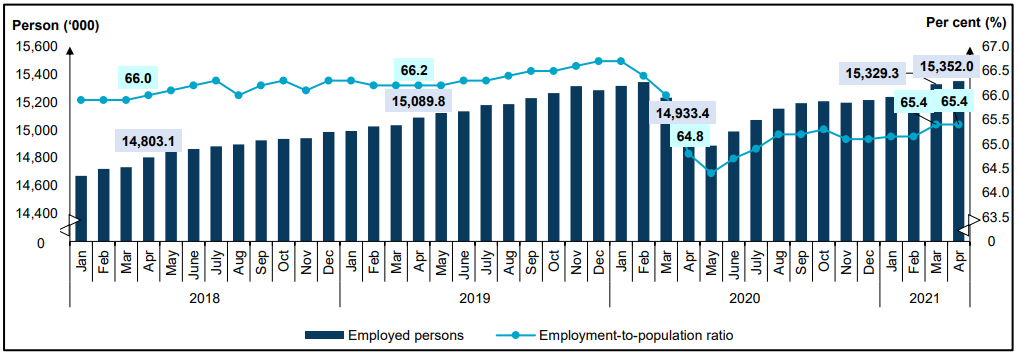
In April 2021, the largest composition of employed persons was the employee’s category which comprised of 77.9 per cent, increased by 17.2 thousand persons month-on-month to register 11.96 million persons (March 2021: 11.95 million persons). Similarly, own-account workers registered an addition of 12.3 thousand persons to record 2.49 million persons in April (March 2021: 2.48 million persons). The increase in own-account workers was following the continuous operations of small businesses during the month. [Chart 2]
This group comprised mostly of daily income earners working as small business operators such as small retailers; hawkers; sellers in markets and stalls as well as smallholders.
Chart 2: Employed person by status of employment, March and April 2021
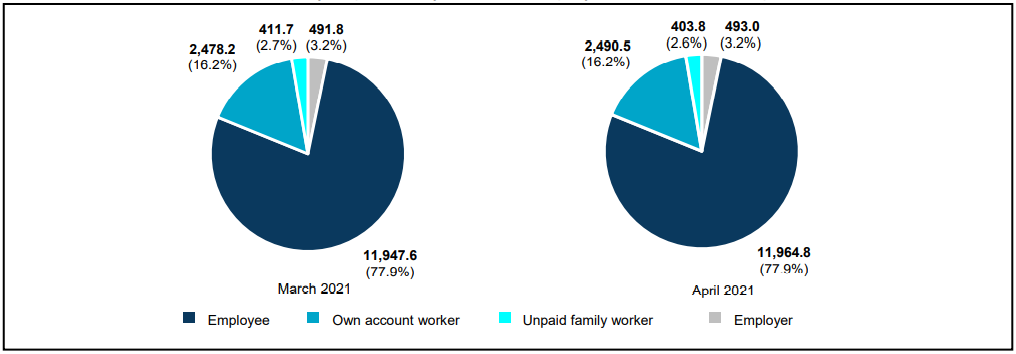
During the month, the number of employed persons who were temporarily not working remained on a declining trend with a reduction of 5.0 thousand persons to record 116.0 thousand persons (March 2021: 121.0 thousand persons). Likewise, comparing with the twelve months earlier, the number of employed persons who were temporarily not working edged down by 5.8 million persons (-98.0%) as against to 5.9 million persons in April 2020 which was during the second months of the total lockdown in the country due to the pandemic. This group of persons, who were most likely not able to work was not categorised as unemployed as they had work to return to.
The unemployment rate continued to decline in April 2021
The unemployment rate continued to decline in April 2021, lessening by 0.1 percentage point to 4.6 per cent as against the previous month (March 2021: 4.7%). The number of unemployed persons reduced by 10.5 thousand persons (-1.4%) month-on-month to register 742.7 thousand persons (March 2021: 753.2 thousand persons).
Similarly, comparing with the same month of the previous year, after posting continuous increase for fourteen months since the beginning of the pandemic, the unemployment rate recorded year-on-year negative changes for the first time due to the high base of unemployment rate (April 2020: 5.0%). During the same period, the number of unemployed persons recorded a decline of 4.6 per cent or equivalent to 36.1 thousand persons (April 2020: 778.8 thousand persons). [Chart 3]
Chart 3: Unemployed persons and unemployment rate, 1982 - 2020 and January 2020 – April 2021

The actively unemployed which is defined as those who were available for work and were actively seeking job encompassed of more than 80 per cent of the total unemployed person. This category was reduced by 8.2 thousand persons (-1.3%) to record 618.7 thousand persons (March 2021: 626.9 thousand persons). Out of the total of actively unemployed, 52.1 per cent were unemployed for less than three months, while 10.4 per cent were in long-term unemployment[1] of more than a year. The average share of the unemployed persons of more than a year was much higher as compared to the previous year, thus indicating that the country is experiencing a slow term in hiring the unemployed persons. [Chart 4]
The same scenario was witnessed in the number of inactively unemployed who believed that there were no jobs available. The number was lowered by 2.3 thousand persons (-1.8%) for the second consecutive months to record 124.0 thousand persons (March 2021: 126.3 thousand persons).
Chart 4: Unemployed category and duration of unemployment, March and April 2021
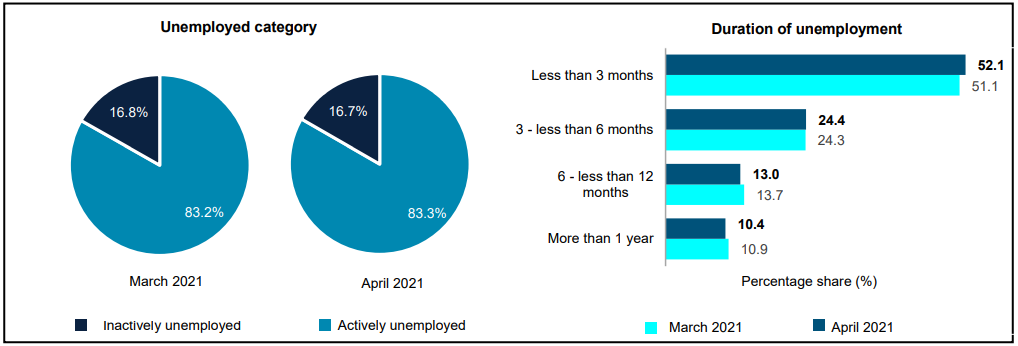
During the month, the youth unemployment rate for aged 15 to 24 years registered an increase of 0.3 percentage points to record 13.7 per cent as compared to March 2021 (13.4%). On the contrary, the number of youths unemployed fell by 10.4 thousand persons to 310.7 thousand persons as compared to the previous month (321.1 thousand persons). Similarly, the youth unemployment rate for aged 15 to 30 years dropped by 0.6 percentage points to mark 8.7 per cent in March 2021. [Chart 5]
Chart 5: Unemployment rate by selected age groups, 1982 - 2020 and January 2020 - April 2021
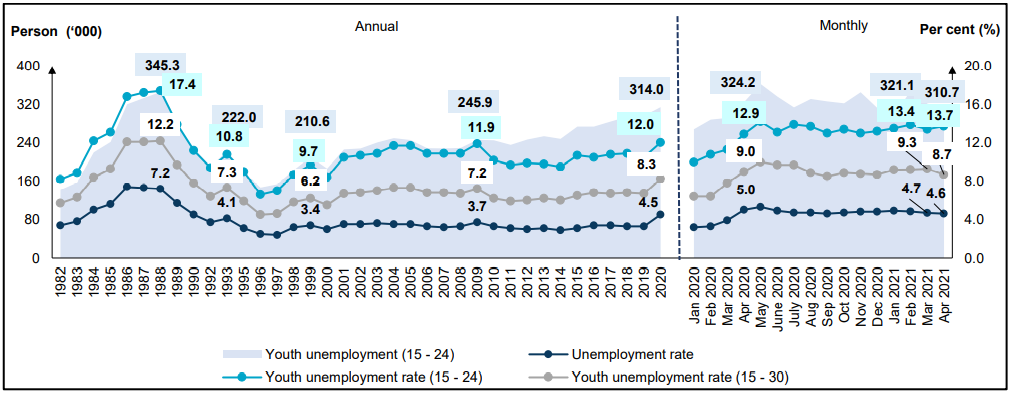
LFPR stood at 68.6 per cent
In April 2021, the number of labour force was higher by 0.1 per cent or 12.2 thousand persons to 16.09 million persons (March 2021: 16.08 million persons). Despite the increase in the number of labour force, the labour force participation rate (LFPR) stood at 68.6 per cent during the month (March 2021: 68.6%).
Likewise, the number of labour force was added up by 382.5 thousand persons (2.4%) year-on-year (April 2020: 15.71 million persons) while the LFPR rose by 0.5 percentage points from 68.1 per cent. [Chart 6]
Chart 6: Labour force and LFPR, 1982 – 2020 and January 2020 - April 2021
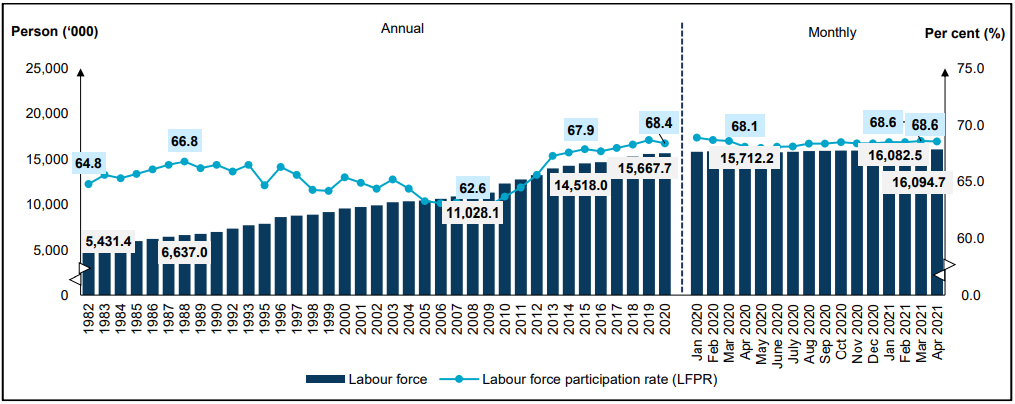
During the month, both male and female LFPR were unchanged with male LFPR marked at 81.0 per cent, while female LFPR was 55.2 per cent. Labour force by sex showed that male labour force declined by 0.1 per cent (-8.9 thousand persons) to 9.84 million persons (March 2021: 9.84 million persons). Meanwhile, female labour force improved by 0.3 per cent (+21.1 thousand persons) to 6.26 million persons (March 2021: 6.24 million persons). In comparison to one year earlier, male and female LFPR heightened by 0.1 percentage point and 0.7 percentage points respectively. [Chart 7]
Chart 7: Labour force and LFPR by sex, 1982 - 2020 and January 2020 – April 2021
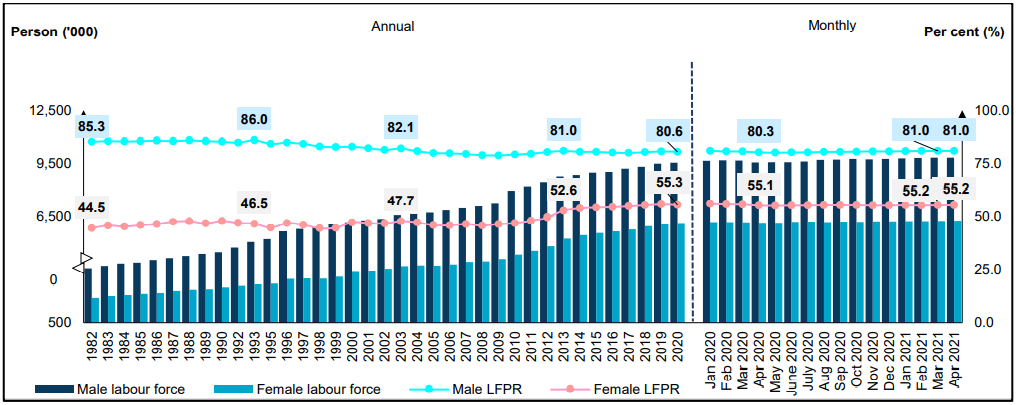
Outside labour force was dominated by schooling/ training categories
The number of outside labour force during the month was higher by 0.2 per cent (+13.1 thousand persons) to 7.38 million persons as compared to 7.36 million persons in March 2021. Likewise, outside labour force climbed up by 0.4 per cent (+31.7 thousand persons) in the same month of the preceding year. Outside labour force was dominated by schooling/ training category with 43.5 per cent (3.21 million persons) and followed by housework/ family responsibilities category with 42.1 per cent (3.10 million persons). [Chart 8]
Chart 8: Share of outside labour force by reasons for not seeking work, March and April 2021
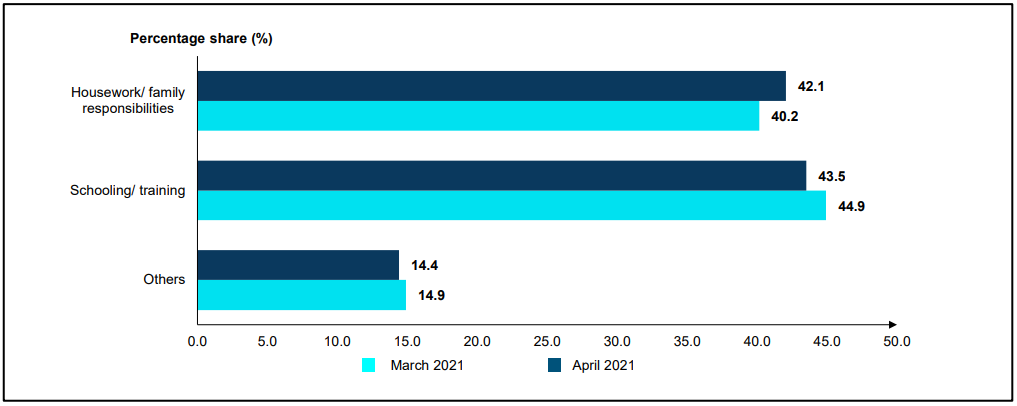
GOVERNMENT’S INITIATIVES
A total of 322,177 employers and 2.64 million registered employees under the Wage Subsidy Programme (PSU) 1.0 had been benefited under PRIHATIN and PENJANA. As of 23 April 2021, the approved wage subsidy applications totalled RM12.88 billion. In the meantime, a total of RM1.17 billion was distributed to 73,567 employers to support them in continuing their operations as well as maintaining the 635,748 employees. Furthermore, 137,075 persons were accepted to participate in the Reskilling and Upskilling Program's courses, which were offered by a selected ministries and government agencies. In addition,132,403 employees were able to obtain job under the Recruitment Incentive and Training Assistance Program. Manufacturing, as well as wholesale and retail trade, were some of the most common industries and areas in which workers are employed.
To support the businesses, through the PENJANA SME Financing, a total of 7,424 applications with a total loan value of RM1.39 billion were granted. Moreover, a total of RM421.1 million was disseminated to assist 12,662 Micro SMEs, including those in the retail and services sectors through the PENJANA Microcredit Financing under Bank Simpanan Nasional (BSN). To support the Agriculture and Food Industry, a total of RM107.23 million was distributed to aid 9,400 agricultural micro-SMEs through the Agrobank Microcredit Financing Scheme. Meanwhile, a total of RM1 billion has been apportioned by the government for SMEs and micro-SMEs which were still impacted by COVID-19. As of April 23, there were 644 applications for PENJANA Tourism Financing with 321 had been approved totalling RM63.9 million. Additionally, a total of RM226.8 million fund had been channelled to 749 SMEs under the Bumiputera Relief Financing (BRF) which particularly designated for the affected Bumiputera SMEs.
Furthermore, to support the Technical and Digital Mid-tier Companies (MTCs), a total of RM65.3 million was disseminated to 13,864 SMEs and companies under the Technical and Digital Utilisation support initiative in the form of grants and loans for digitisation services subscription. Additionally, a total of 229 applications costing RM106.4 million were received for MyCreative Venture to assist the Arts, Culture and Entertainment sector, with 117 applications worth RM21.7 million being approved amounting to RM21.7 million. Meanwhile, the CENDANA programme has channelled a total of RM3.01 million to 469 recipients, including artists, collectives, and organisations operating in the Malaysian arts and culture sector.
Hence, it is hoped that the labour market will remain stable with the injection of support from various initiatives implemented despite the worsening state of the country's health crisis.
LOOKING AHEAD
May 2021 witnessed the public health crisis situation in Malaysia becoming more challenging with a rise in the number of daily infections cases, hence resulting in the implementation of MCO 3.0 nationwide until 31 May 2021. During this phase, most of economic sectors were allowed to operate, although employers had to adopt work from home policies with not more than 30 percent of management-level staff in the premises in addition to closures of all educational institutions while social events, sports activities, games and recreation were prohibited. Inter-states and inter-district travels were also restricted with certain exceptions. This scenario signalled some challenges to the labour market in May especially to the new entrants and small business operators.
Furthermore, the escalating number of COVID-19 cases and the sharp increase in daily cases towards the end of May 2021, resulted in the implementation of the total lockdown imposed nationwide from 1 to 14 June 2021 with the closure of all economic and social sectors except for essential economic and service sectors. Hence, labour market condition is foreseen to face another challenging situation in the upcoming months.
Nevertheless, with the implementation of various initiatives under the PEMERKASA Plus assistance program, including the extension of the wage subsidy program for a month to all affected sectors of the economy, the increase in the rate of Special Prihatin Grant by RM500 to RM1,500, the facility of assistance facilities and targeted recovery to affected SMEs, one-off special assistance to taxi drivers, rental cars, school buses, tour buses, e-hailing & tourist guides, extending the service period of 14,000 medical officers and existing contract nurses, re-appointing over 500 retired health workers this year on a contractual basis to accommodate the urgent needs of health workers and to accelerate the vaccination from 80,000 to 150,000 doses per day to the people by June 2021, therefore, it is hoped that the provision of these various assistances will assist the affected groups as well as help to restore the labour market condition and the public health situation in Malaysia in the months ahead.
TECHNICAL NOTES
This information is derived from the Labour Force Survey (LFS) which was conducted to collect information on the structure and distribution of labour force, employment and unemployment.
The survey population cover persons who live in private living quarters and excludes persons residing in institutions such as hotels, hostels, hospitals, prisons, boarding houses and workers residing in construction work site.
The survey comprises of the economically active and inactive population. To measure the economically active population, the LFS uses the age limit of 15 to 64 years. The economically active population comprises of those employed and unemployed whereas those who are inactive is classified as outside the labour force.
LFS uses the actual status approach, where a person is classified on the basis of his labour force activity during the reference week.
- Labour force refers to those who, during the reference week are in the 15 to 64 years (in completed years at last birthday) and who are either employed or unemployed.
- Employed refers to all persons who, at any time during the reference week worked at least one hour for pay, profit or family gain (as an employer, employee, own-account worker or unpaid family worker). Also considered as employed are persons who did not work during the reference week because of illness, injury, bad weather, leave, labour dispute and social or religious reasons but had a job, farm, enterprise or other family enterprise to return to. Also included are those on temporary lay-off with pay who would definitely be called back to work.
- Unemployed
Unemployed refers to those who do not have a job but are interested to work. There are two groups of unemployed that is the actively unemployed and inactively unemployed.
- Outside Labour Force
All persons not classified as employed or unemployed as stated above are classified as outside labour force. Includes housewives, students (including those going for further studies), retired, disabled persons and those not interested in looking for a job.
- Labour Force Participation Rate
The economic activity of a population depends on the demographic characteristics of that population. The proportion of economically active population, therefore, differs between sub-groups of that population. These variations are measured by specific activity rates termed as labour force participation rate. Labour force participation rate is defined as the ratio of the labour force to the working age population (15 to 64 years), expressed as percentage.
- Unemployment rate is the proportion of unemployed population to the total population in labour force. This rate measures the percentage of unemployed population in the labour force.
Population by characteristics of age group, ethnicity and state were used as benchmarks to produce labour statistics.
Starting with the monthly release of the Principal Statistics of Labour Force, Malaysia, January 2016, the principal statistics of labour is estimated based on the current population estimates as compared to the previous series which used population projections based on the Population and Housing Census of Malaysia, 2010. This rebase is to obtain statistics that is more consistent with current population structure.
The full publication of the Labour Force Report, April 2021. This report is accessible and downloadable through the application eStatistik Portal, Free Download
For more details, please refer to the Department’s portal: www.dosm.gov.my
Released By:
DATO' SRI DR. MOHD UZIR MAHIDIN
CHIEF STATISTICIAN MALAYSIA
DEPARTMENT OF STATISTICS, MALAYSIA


9 June 2021
Contact person:
Mohd Yusrizal bin Ab. Razak
Public Relation Officer
Strategic Communication and International Division
Department of Statistics, Malaysia
Tel : +603-8885 7942
Fax : +603-8888 9248
Email : yusrizal.razak@dosm.gov.my
Subscribe
Newsletter
Subscribe to our newsletter and stay updated
For interviews, press statement and clarification to the media, contact:
Baharudin Mohamad
Public Relation Officer
Email: baharudin[at]dosm.gov.my
Phone: 03 8885 7942
Not found what you looking for? Request data from us, through
Go to eStatistik
email to data[at]dosm.gov.my
call 03 8885 7128 (data request)









